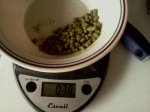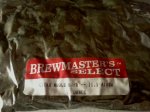
The beer that started it all.
So I decided I was sick of the combo amarillo, simcoe, cascade, centennial, columbus, (fill in your samey-same american hop here). I wanted something different. Well, not that different as far as the beer industry goes, or for that matter any given brew pub in the USA, I wanted a different pale ale. Not just any Pale, an American Pale…..Not just any pale…the perfect Pale Ale. One that has the great hop profile, an aroma you can write your name in! But even a pale ale MUST have some balance to it. A good Pale will stand out from the rest if you have a good malt profile as well. Why is it that no-one ever pays enough attention to the malt bill in a pale! It’s always the same : a 2-row or Pale malt base and some crystal-60L or some other variety of that nature!

A good pale ale starts with a good malt recipe.
Sierra Nevada paved the way for all homebrewers. The took the simplest malt recipe:basically the 2-row pale and some crystal 60L and nothing else. It was a showcase of the American hops and their citrus/piney profile. This was especially true for the cascade hop which takes the forefront in this ale. It is used as a finishing hop ,which is very clear if you have ever had one. Unless you have been living under a rock or in Canada, this beer is EVERYWHERE!
http://www.sierranevada.com/beers/paleale.html It should get all the respect it deserves, after all if there was no Sierra Nevada maybe…just maybe there would have never been a craft beer revolution and you would still be drinking macro-brews and still have your beer blinders on. The
American Pale Ale was pretty much invented by this company and if you read the
BJCP guidelines on an American Pale Ale it will basically describe Sierra Nevada Pale Ale.
http://www.bjcp.org/2008styles/style10.php But even though they invented the style (american pale) it is not the be-all, end-all of pale.
- Start with a good malt bill
I had the notion of building the perfect pale when I came across some Citra whole hops. I have found,( and read), that homebrewers either love these hops or hate them entirely. I love them. The have a citrus/fruity thing going on. Reminds me of tropical fruit or mangoes but still retains a very American profile.
http://en.wikipedia.org/wiki/List_of_hop_varieties So the idea is to build a beer around my favorite American hop, Citra. I chose to use a clean american 2 row malt known as brewers malt. Nice and clean to provide a toasty twist with a half pound of Special Roast Malt and half pound of Victory. This should give a good malty balance to the great fresh whole hops to used in the finish and the dry hop addition. I chose these two specialty malts because of the way each of them play off the other in terms of flavor. I have found that the tend to give off a toasty,somewhat nutty brown ale-type flavor. At a 1/2 LB of each it will not overwhelm, but act in a supporting role for the star…the Citra.
- Getting the hops to stand out
There are few tricks to get the most out of your hops whether you are talking: bitterness, flavor , or aroma. If you don’t know much about water chemistry when it comes to home brewing now is a great time to learn. (As a refresher….very abridged) There are minerals in you water that do pretty much 2 things: A). dictate the PH level or B). define the chloride to sulfate ratio. Meaning if you have more of the ion sulfate in your tap water as opposed to the ion chloride, your beers will tend to lean towards or magnify the hops in your beers..specifically the bitterness. And just the reverse will favor the sweetness of the malt. So the key here is: know your water chemistry and your sulfate to chloride ratio. That way if you are low in sulfate in your water you can add back some food grade gypsum( calcium sulfate), to enhance the hoppiness! Although some brewers are skeptical when it comes to this subject, trail and error will tell. After all, it’s not about numbers and ratios, it’s about making great tasting brew and you should trust your taste buds more than ANYTHING! So be your own judge.

Food grade gypsum is added to the mash to increase calcium levels as well as sulfates: which tend to enhance hops
Finishing or flavor hop additions in the final moments of the boil are an essential part of making the perfect pale ale. After all its the hops that should the star of the show. Pale ales are a great beer to showcase the aroma and flavor of your favorite hops. The finishing stage is where the flavor and aroma will come to life. I find that there
is no substitute when looking for flavor and aroma than fresh hops. It is a personal preference, but indulge in the fact that the whole hops(sometimes called leaf of fresh hops) are less processed and handled than the pellets. So my suggestion is save the pellets for the bittering addition in the beginning of the boil, and save the good fresh stuff for last. Try it, you
will notice a difference.

Save the pellet hops for bitter additions in the boil.
- Dry hopping for killer aroma
Dry hopping is absolutely key to a fresh aroma, which is the tell-tale sign of a good pale. It is the practice of adding raw hops to the freshly fermented beer that is defined as “dry hopping”. You are adding dry hops to the beer, thus not subjecting the fragile lupulin to the heat of the boil. This in turn imparts a “fresh hop aroma” to the beer. Dry hopping in my opinion should be done in the serving keg (if you keg). You
do not necessarily have to secondary just for dry hopping. Just wait for the beer to reach final gravity and then add your dry hops to your primary fermenter. The beer will retain more hop aroma if it is stored cold…which is why I say add them to your serving keg! All of that also depends on how long you keep the hops in contact with the finished beer.

Citra Whole hops used for flavor and aroma.
The American pale ale is most commonly fermented using a “clean” ale yeast. Something that ferments fully and leaves the beer somewhat dry, and something that will not put off fruity esters that will interfere with the hops and malt. This is where I call Bravo Sierra: (Bulls**T)! Again… always trust your taste buds. You should use what ever compliments your beer the best. Sometimes a “fruitier” ale yeast will compliment the hops of your choosing. Other times you want to keep the yeast profile much more restrained and use something a little cleaner. I chose a california common yeast because this yeast is known to be very clean and has the tendency to enhance hops in brew.(it is the Anchor Steam Beer yeast).I feel this is the best of both worlds. It is a lager yeast which is bottom fermenting, that ferments at ale temps, but still remains pretty clean well into the mid 60 degrees F range. (not to mention that I had a yeast cake of it coming out of another batch.)
So in closing, an American Pale Ale is a very simple beer to brew. But it is difficult to make an outstanding one. It is one of the most popular beer styles among the micro breweries, brewpubs ,and homebrewers alike. Don’t make the same old stuff…think outside the box and make the perfect American pale ale. As a brewer you owe it to yourself to enjoy a great pale ale.
Batch Size: 6.50 gal
Boil Size: 8.30 gal
Estimated OG: 1.062 SG
Estimated Color: 7.1 SRM
Estimated IBU: 35.6 IBU
Brewhouse Efficiency: 86.00 %
Boil Time: 60 Minutes
Ingredients:
————
Amount Item Type % or IBU
12 lbs Pale Malt (2 Row) US (2.0 SRM) Grain 92.31 %
8.0 oz Special Roast (50.0 SRM) Grain 3.85 %
8.0 oz Victory Malt (biscuit) (28.0 SRM) Grain 3.85 %
1.00 oz Citra [11.10 %] (Dry Hop 7 days) Hops –
0.65 oz Warrior [17.00 %] (60 min) Hops 29.6 IBU
1.00 oz Citra [11.10 %] (*5 min) Hops 5.9 IBU
1 Pkgs California Lager (Wyeast Labs #2112)
Total Grain Weight: 13.00 lb
*Add the finishing hops not just at 5 minutes, but over the last five minutes continuously.

It may be too early for you tell about Citra. But, do they age well? I bottle condition my beer and the Citra starts great and after 1 1/2-2 months, I pick up an off taste. It may have contamination that over time overcomes the Citra goodness. Have you noticed any off flavors?
I have never noticed any off flavors at all. Maybe if you could explain exactly what you are tasting I might be able to help you out some. I tend to keg way more than bottling, just cause’ its easier, and I usually dry hop in the serving keg. If this were a problem with the “breed” of Citra, I’m sure I would taste it direcly off of dry hops in the keg. I have only had it on tap for about a 1 1/2 weeks so, if it sticks around long enough I will report back. It is tasting pretty good right now…not sure if it will make it through the holidays! Cheers
Thanks for the feedback Matt,
I have not yet bit the bullet for kegging and still bottle condition my beer. The off taste is close to a sour cider. I love Citra, but this aging difficulty gives me pause. Keep a taste bud out for it, if your batch makes it a couple of months.
Cheers.
To update you, so far I have not noticed anything like a sour taste.I do notice the hops changing flavor somewhat though, but not sour. Is it possible you maybe confusing this citrusy hop flavor with some sour notes? I think they remind me of “grapefruit” when they age a little and you could be experiencing the same flavor. It is still a great pale though. Just keeps getting better. I will post a tasting profile in the next few days. hope that helps some?
I did brew a Citra IPA that Gordon Strong tasted and for that batch I used honey to bottle condition. I think that the honey is good for the conditioning because of the added benefit of its being anti-bacterial. That honey Citra IPA went 4 months before it peaked.
Priming with honey is a great idea. It is 100% fermentable and the anti-bacterial angle is something that has never crossed my mind. I would think it would add “some” flavor as opposed to corn sugar which I am not a huge fan of. I will definitly try using honey next time for priming my kegs/bottles.